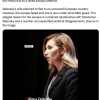This video has been circulating on social media recently. It purports to show a person standing atop the Great Pyramid of Giza waving two Palestinian flags. It is currently illegal to climb the pyramid, with offenders facing up to 3 years of jail time. The footage appears to have been taken with a drone and does seem to depict the pyramids. However, we look a closer look at the person and flags in the video and noted from a quick visual inspection with the naked eye that the tone and brightness of the sunlight on them differs from the pyramid itself. We then conducted a reverse image search to find the source of the footage.
The footage appears to have been taken with a drone and does seem to depict the pyramids. However, we look a closer look at the person and flags in the video and noted from a quick visual inspection with the naked eye that the tone and brightness of the sunlight on them differs from the pyramid itself. We then conducted a reverse image search to find the source of the footage.
This specific video originates from a Tiktok account, 100.pixels and was posted on 13th April. However, the reverse search also produced a similar video posted by the same user in 2019 which appears to be a 360 degrees drone shot of the pyramid without a person standing atop it.
As also done by AFP Fact Check, a comparison of the two videos shows that while the colour grading and cropping of the videos are slightly different, the angle and vantage points of the two videos appear identical – suggesting that the recently posted clip has been altered from the 2019 footage to include the person waving Palestinian flags. Although this has not been confirmed by the original poster (who uses the handle 100.pixels on different social media accounts and describes himself on Instagram as a “creative director” and “VFX-3D Artist”), the Director General of the Giza Plateau archaeological site has said in a statement to AFP that the video is “not a real footage.”
Although this has not been confirmed by the original poster (who uses the handle 100.pixels on different social media accounts and describes himself on Instagram as a “creative director” and “VFX-3D Artist”), the Director General of the Giza Plateau archaeological site has said in a statement to AFP that the video is “not a real footage.” In sum, considering the barriers to climbing the pyramid, the original poster’s track record of posting other (more obviously) edited videos of pyramids in support of Palestine, the similarities between the 2019 video, and the denial by an Egyptian source we give this claim a rating of False.
In sum, considering the barriers to climbing the pyramid, the original poster’s track record of posting other (more obviously) edited videos of pyramids in support of Palestine, the similarities between the 2019 video, and the denial by an Egyptian source we give this claim a rating of False.

Given Egypt’s proximity to the Gaza strip and the ongoing Israel-Hamas conflict, the circulation of altered videos such as this only add to the confusion – potentially stoking arguments, tensions, and misunderstandings amongst those who believe they are real.
The proliferation of altered videos that might seem harmless or “for fun” muddies the waters – particularly when they are presented as real and unaltered. The use of devices with relatively small screens can also make it difficult to notice potential red flags of inconsistencies in videos at first glance. Regardless of intent, it is important for us as media consumers to be able recognise when videos are altered – in doing so, we reduce the possibility of being fooled or misled into spreading mis/disinformation.



